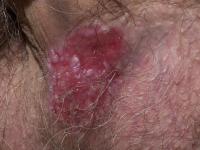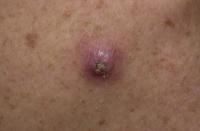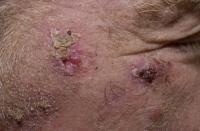Squamous Cell Carcinoma
Squamous Cell cancers are the second most frequent form of skin cancer, representing about 20% of all skin cancers diagnosed. These cancers typically appear on any light exposed areas of the body, but are particularly common on the face, balding scalp, and upper extremities. A familial tendency for this type of cancer is a predominant factor. However, heavy sun exposure, burns, and radiation injuries are also common precursors of squamous cell cancers.
Squamous cell cancers can spread to other parts of the body and may interfere with life expectancy, although this is highly atypical. Differentiating between these tumors is difficult. If you have any doubts, see a dermatologist. There are three primary types of squamous cell tumors, each of which is described below in detail.
Bowen’s Disease
 Bowen’s disease is the most common squamous cell tumor. These cancers begin as dry scaly patches similar to a dermatitis, however their condition does not improve with the use of lotions or creams.
Bowen’s disease is the most common squamous cell tumor. These cancers begin as dry scaly patches similar to a dermatitis, however their condition does not improve with the use of lotions or creams.
If left untreated these superficial cancers can become more aggressive. Early surgical intervention is the treatment of choice.
Keratoacanthoma
 A common type of squamous cell cancer is the keratoacanthoma. It is a rapidly growing tumor which tends to appear suddenly and may reach a considerable size. This tumor is often dome-shaped with a central area resembling a crater which is filled with a keratin plug.
A common type of squamous cell cancer is the keratoacanthoma. It is a rapidly growing tumor which tends to appear suddenly and may reach a considerable size. This tumor is often dome-shaped with a central area resembling a crater which is filled with a keratin plug.
These tumors may resolve themselves, however the cosmetic results are often unacceptable as large amounts of tissue may be destroyed by the rapidly growing cancer.
Infiltrating Tumors
 The infiltrating tumor is the most aggressive form of squamous cell cancers. They often appear first as a thick plaque or rough ulceration of the skin. Typically, they arise out of or under actinic keratoses (rough spots from the sun) or cutaneous horns. Over time these rough spots become tender, develop a lump and begin to grow larger. As the body reacts to the changing tumor, a red halo develops surrounding the affected area. These tumors are capable of spreading to other parts of the body. Early surgical intervention is highly recommended.
The infiltrating tumor is the most aggressive form of squamous cell cancers. They often appear first as a thick plaque or rough ulceration of the skin. Typically, they arise out of or under actinic keratoses (rough spots from the sun) or cutaneous horns. Over time these rough spots become tender, develop a lump and begin to grow larger. As the body reacts to the changing tumor, a red halo develops surrounding the affected area. These tumors are capable of spreading to other parts of the body. Early surgical intervention is highly recommended.

